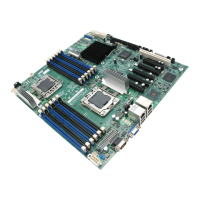VMware vSphere* 4.1 Installation Guide for ESX/ESXi* 4.1
8
Customers deploying simple server solutions can consolidate 5-10 servers on a single platform to lower
operating costs while delivering good performance.
Server Configuration Options and Selection Criteria
The Intel® Xeon® processor 5600 Series performance benefits provide improved performance on
virtualization solutions compared to the previous generation Intel® Xeon® processor 5500 Series.
Intel® Server Boards provide sufficient memory for running virtual machines. Maximizing the amount of
memory on the board will provide more memory for each virtual machine. To enhance performance, VMware*
recommends installinig ESX* on a robust system with more RAM than the minimum required and with
multiple physical disks. Consider the following recommendations for enhanced performance:
RAM: ESX* 4.1 hosts require more RAM than typical servers. An ESX 4.1 host must be equipped with
sufficient RAM to run concurrent virtual machines. Running these four virtual machines with 512 MB
RAM requires that the ESX 4.1 host be equipped with approximately 4 GB RAM, which includes 2,048
MB for the virtual machines.
Dedicated Fast Ethernet Adapters for Virtual Machines: Place the management network and virtual
machine networks on different physical network cards. Dedicated Gigabit Ethernet cards for virtual
machines improve throughput to virtual machines with high network traffic.
It is also recommended to purchase a quad-port Network Internet Card for improved networking and I/O
performance while providing redundancy in case of failure. With virtualization applications, it is important to
provide redundancy when consolidating server applications on a single system because multiple applications
will fail with a single point-of-failure. With the addition of a quad-port NIC for the server, there are four
additional ports available to each VMware* host for either additional networking bandwidth for virtual
machines as well as redundant paths.
Typical deployments would dedicate two ports for the management interface, two ports for the storage
interface and two ports for the VM network. Additional ports may be needed for the vm network depending
on the network load. Customers with high network bandwidth requirements for their application would want
to consider InfiniBand* or 10GE interfaces for even more network capacity. The server board and platform
options depend on the number of Virtual Machines that will run on an ESX* server:
Intel® Server Board S5520UR and Intel® Server Board S5520HC are ideal for scalable high-
performance virtualization. The increased memory supported on each server board allows for more
virtualization machines to be deployed because more memory can be allocated for each Virtual Machine.
Intel® Server Board S5520UR is rack-mounted for data centers and Enterprise IT. Intel® Server Board
S5520HC is ideal for customers wanting a pedestal chassis virtualization solution for office
environments. Intel® Server Board S5520UR and Intel® Server Board S5520HC each has up-to 96
GB of memory and expansion for I/O cards, making them ideal for virtualization. For maximizing the
number of Virtual Machines and supporting more I/O, these server options provide the best possible
performance and scalability for virtualization. Intel® Server Board S5520URT and Intel® Server Board
S5520HCT are required for support of Intel® TXT. Refer to the Intel® Server Boards Product Page at
http://www.intel.com/products/server/motherboard/index.htm#s1=all&s2=S5520HC&s3=all to see
which Intel® Server Boards support Intel® TXT.

